Pan Am Postcards
There are many postcards in circulation that show Pan Am aircraft. However, very few were actually produced by Pan Am. The postcards shown below are Pan Am issue and are known to be so by the logo featured on the back of the card.
The first two cards below show an artist rendition of an unidentified Clipper on the left and a Boeing 307 “Stratoliner” on the right. Pan Am had a fleet of 3 Stratoliners which began service with the airline in 1940.
In the middle set of pictures are two examples of the Boeing 377 “Stratocruiser.” This original fleet of 21 aircraft joined the Pan Am in 1949. An additional 8 Stratocruisers joined Pan Am when it acquired American Overseas Airlines (AOA) in 1950. The original Pan Am fleet all had registration numbers ending with the letter “V” and round windows in the lower deck lounge. The AOA fleet all had registrations ending with a numeral and square windows in the lower deck lounge.
The bottom two pictures show the DC 6 on the left and the DC 7 on the righ. Pan Am first flew the DC 6 in 1952 and acquired 50 of the type. The DC 7 joined Pan Am in 1955 and a total of 33 joined the fleet.
Some of the early Pan Am postcards were of destinations. Below on the left is a scene from Panama and in the center a scene from Mexico. These postcards date from the late 1940s or early 1950s and have descriptions on the back in English, Spanish and Portuguese. On the right is a picture of a Pan Am flight attendant posing by the tail of a Boeing Stratoliner (details on this aircraft above). This postcard dates from the early 1940s.
Pan Am launched the jet age for American aviation on October 28, 1958 when it placed the Boeing 707-120 in service between New York & Paris. Pan Am flew 8 of this first version of the 707. The later model 707-320 joined the Pan Am fleet beginning in 1959. Pan Am flew 120 of the later model for a total of 128 in the 707 fleet. Additionally Pan Am flew 9 Boeing 720Bs a smaller version of the 707 (the 720 can be distinguished from the 707 by the fact that it only has one over wing emergency exit while the 707 has two). Pictured below are 6 Pan Am issued postcards depicting the 707.
Below is one final postcard of a Boeing 707 flying into the sunset. Under that is a Pan Am issued postcard depicting the 707 lounge on the left and the First Class caviar service on the right.
Pan Am took delivery of its first Boeing 727-100 in 1965 and acquired an initial fleet of 27. The three postcards below are from the initial Pan Am fleet. The fleet was used in both the Caribbean & Internal-German markets. In 1980 Pan Am acquired an additional 19 of the 727-100s from it’s merger with National Airlines.
Via the merger Pan Am also acquired 24 of the larger 727-200s. During the 1980s Pan Am would acquire 27 additional 727-200s for a combined fleet of 51. To my knowledge there are no Pan Am issued postcards of the 727-200s.
Pan Am was the launch customer for the Boeing 747-100 and inaugurated service from New York to London in January of 1970. Thirty three of the aircraft were delivered to Pan Am initially. Through the years Pan Am would take delivery of an additional 21 747s including 10 of the longer range 747-200. Below are three Pan Am issued postcards of the 747-100 including 2 photographs and one artist rendition.
Below on the left is Pan Am issued postcard showing the spaciousness of the Economy section of the 747-100. On the right is a postcard of the First Class “Sleeperette” seat on the 747SP. A postcard of the 747SP can be seen below the interior shots. Pan Am was once again the launch customer of the 747SP when nonstop service was introduced between New York and Tokyo in April of 1976 and acquired a fleet of 11 of this aircraft.
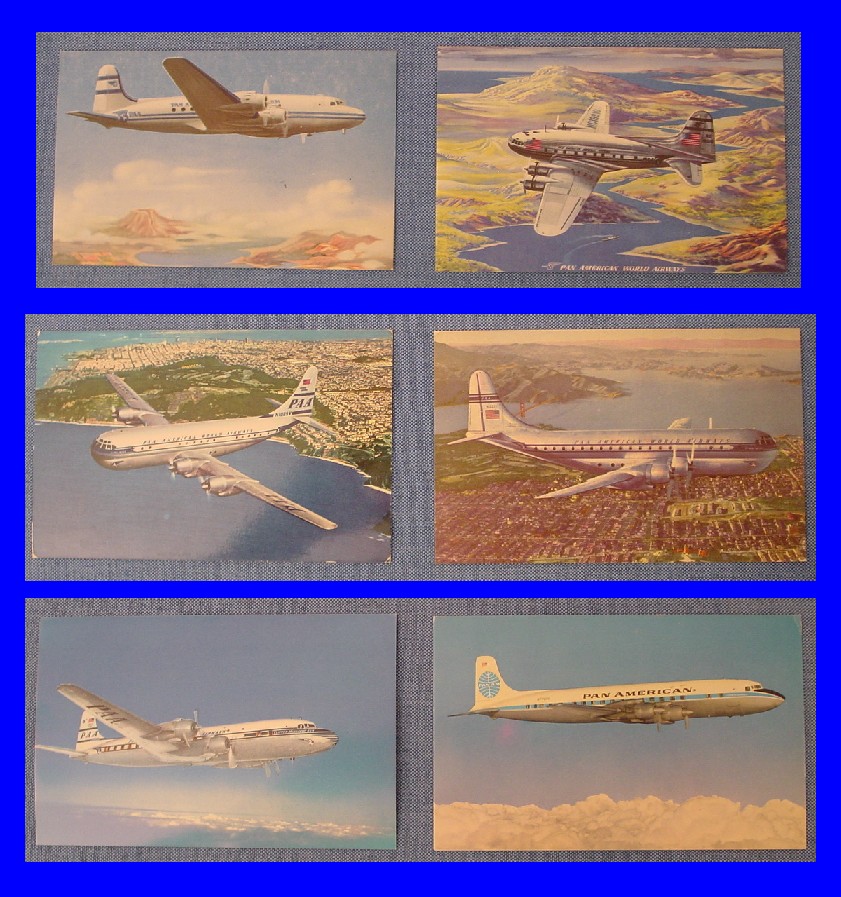
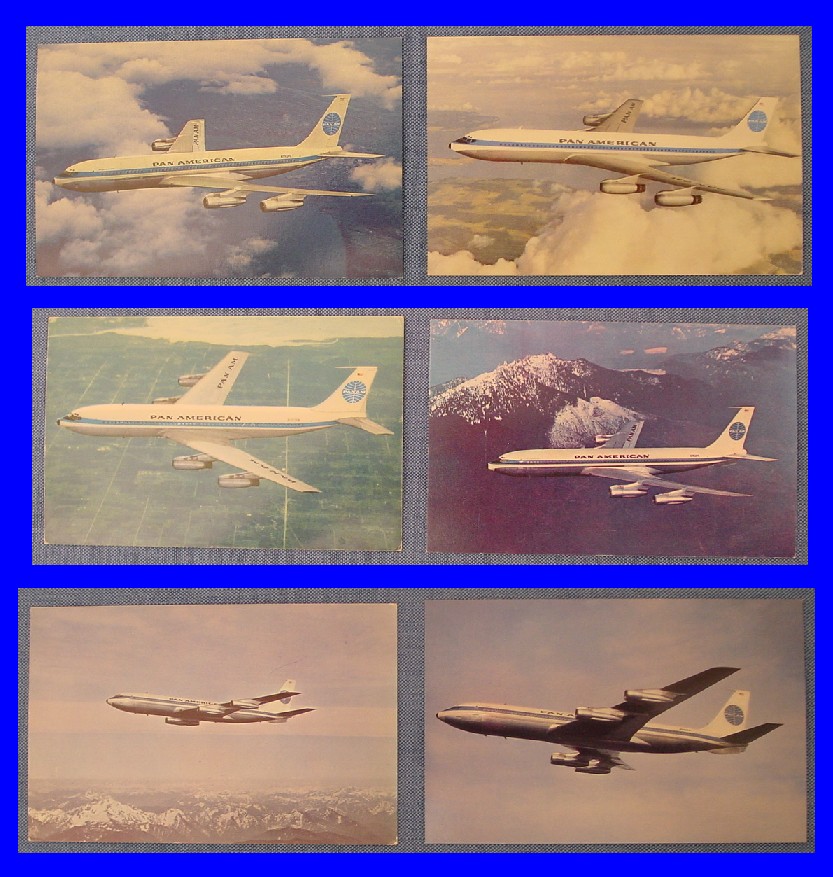
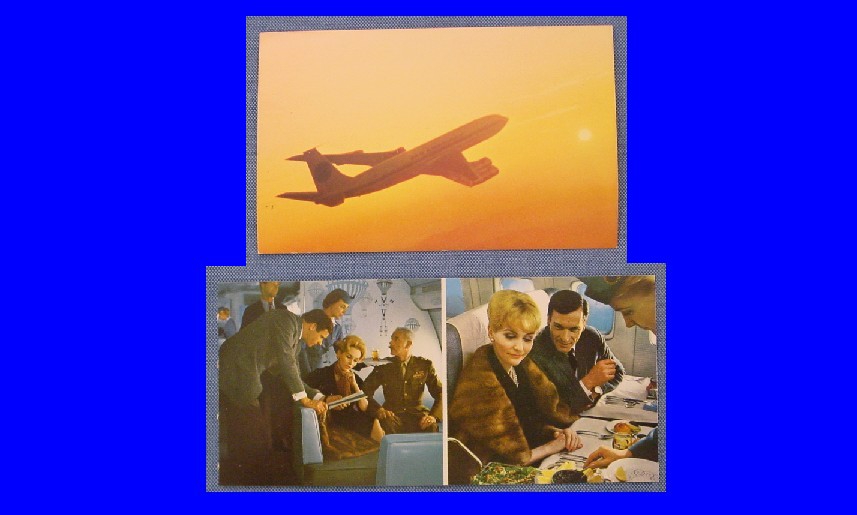
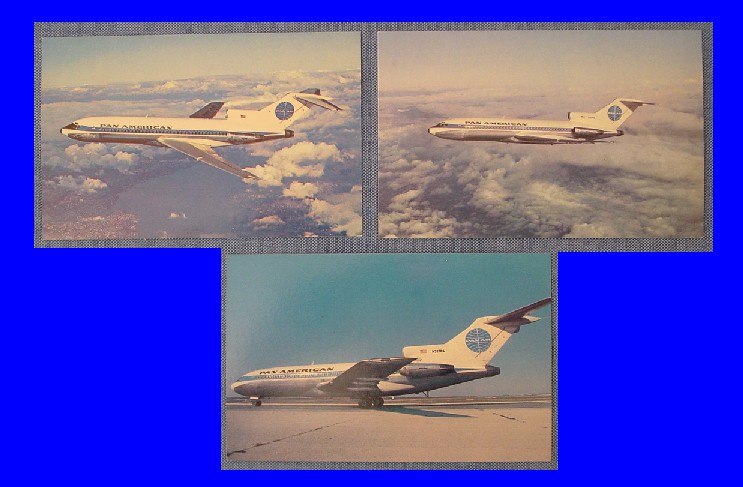

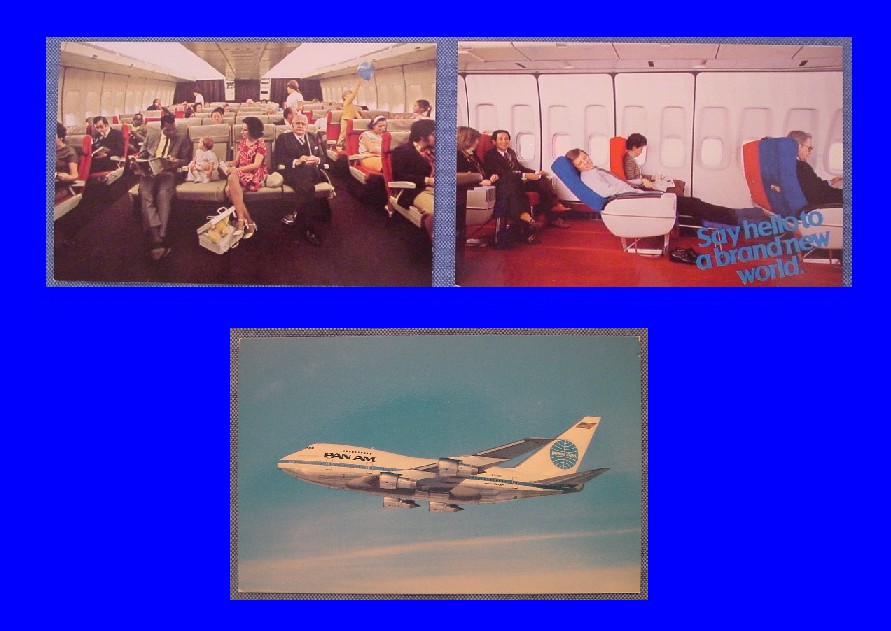
In the late 1970s Pan Am produced a series of destination posters. It was decided to offer these for sale to the public. Postcards were produced of the posters with a flap that could be detached for ordering. Below are several examples of this series.
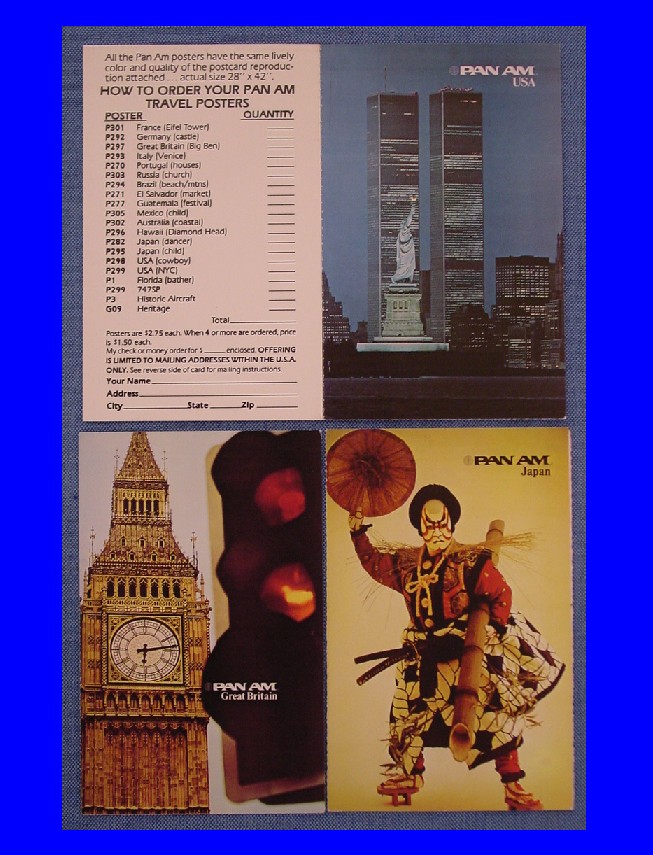
In 1977 as part of its 50th Anniversary celebration Pan Am commissioned a series of paintings by an artist named John McCoy. The paintings depicted Pan Am aircraft on first flights and other notable missions. The McCoy images were used sold to the public as high quality lithographs as well as used by Pan Am for posters, menu covers and even postcards. The postcards were used in-flight from the early 1980s onward. Below are 4 examples of the McCoy images. Pan Am would have McCoy paint two more pictures in later years to include the Lockheed L1011 and Airbus A300 which joined the fleet after 1977.
The McCoy image on the upper left depicts a Lockheed Constellation arriving back to San Francisco after completing the first commercial round-the-world flight on June 29, 1947. Pan Am introduced the Constellation to the fleet in 1946 and took delivery of 34 of the type.
Below in the upper right position is a Pan Am DC 4 in the Belgian Congo after inaugurating service from the United States on January 19, 1946. Pan Am introduced the DC 4 in 1945 and took delivery of 92 of the aircraft.
Below on the lower left is a Lockheed L1011-500 aircraft. This version of the L1011 was smaller than the original aircraft and had a substantially longer range of 5,500 miles. The postcard depicts Pan Am’s inaugural flight with the aircraft from New York to Caracas on May 1, 1980. Pan Am flew a total of 12 of this type.
Finally in the lower right position is the McCoy version of the Pan Am 747SP (detailed above) on its inaugural flight from Los Angeles to Tokyo a nonstop distance of 5,478 miles on April 25, 1976.
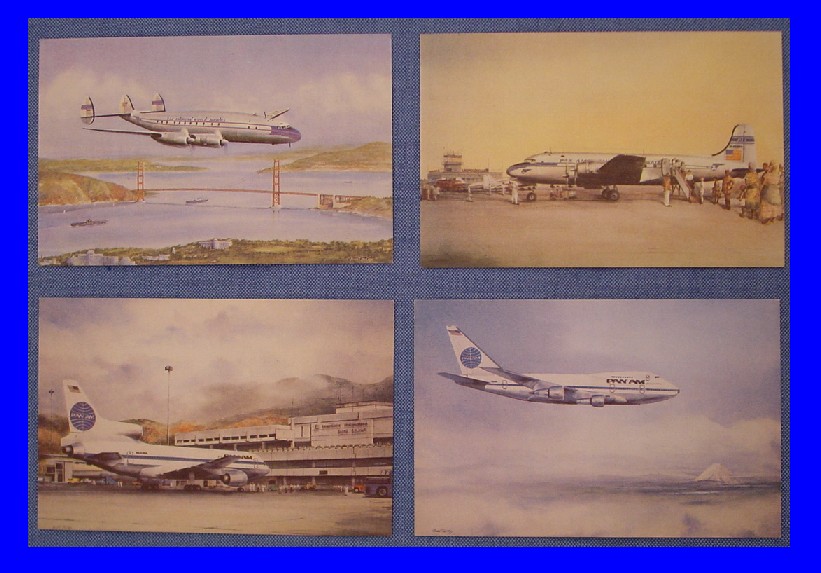
Pan Am was one of the first airlines to serve Alaska and at one time Pan Am had a fairly extensive route network to the region. Flight attendants wore boots and blue parkas as their uniforms in the region. Below on the left is 1950s menu postcard from Pan Am’s Alaska service.
On the right is a route map postcard from the 1980-81 period when Pan Am’s advertising slogan was “Say Hello To Pan Am.” The slogan was designed to promote Pan Am in the US domestic market after the January 1980 merger with National Airlines.
On the bottom is an artist rendition of the Boeing Super Sonic Transport. In the mid 1960s Pan Am placed orders for both the Concorde and Boeing SST but after the United States decided not to support the development of an SST Pan Am and other US airlines canceled all orders.
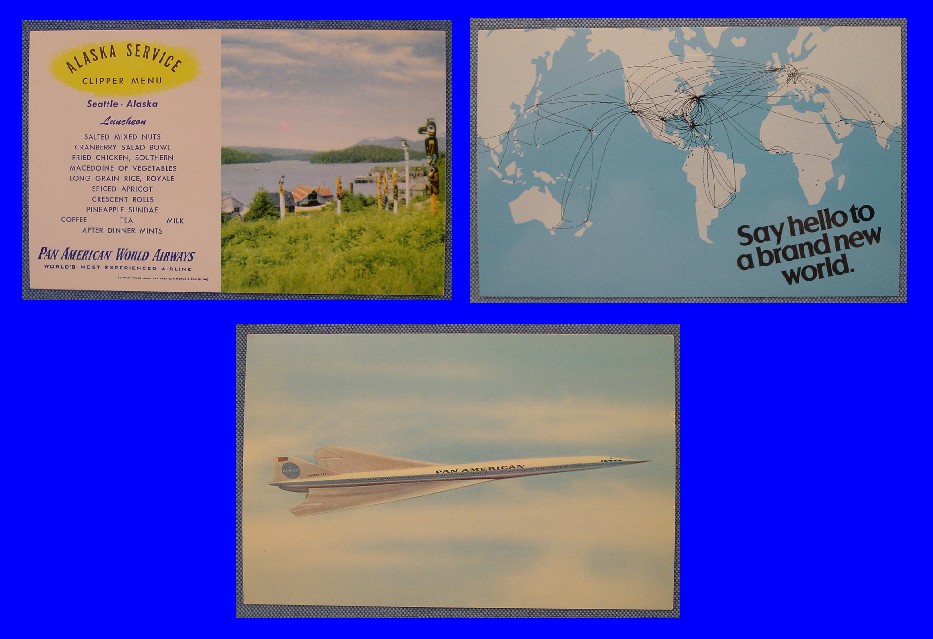
In the 1970s & 80s Pan Am had a mascot, Pierre Panda, for young flyers. Aircraft carried Pierre Panda “fun kits” (more on this below). The three postcards below are from one of the kits. In the upper left is the Sikorsky S40 flying boat. Pan Am took delivery of this aircraft in 1931 and had a fleet of three. On the right is the Boeing 314 flying boat, known as either the “Boeing Clipper or “Yankee Clipper.” Pan Am took first delivery of this plane in January of 1939. Though the company placed orders for 12 Pan Am turned over delivery of 3 to Imperial Airways of England once WWII broke out in Europe. On the bottom is a Lockheed Constellation that was described above.
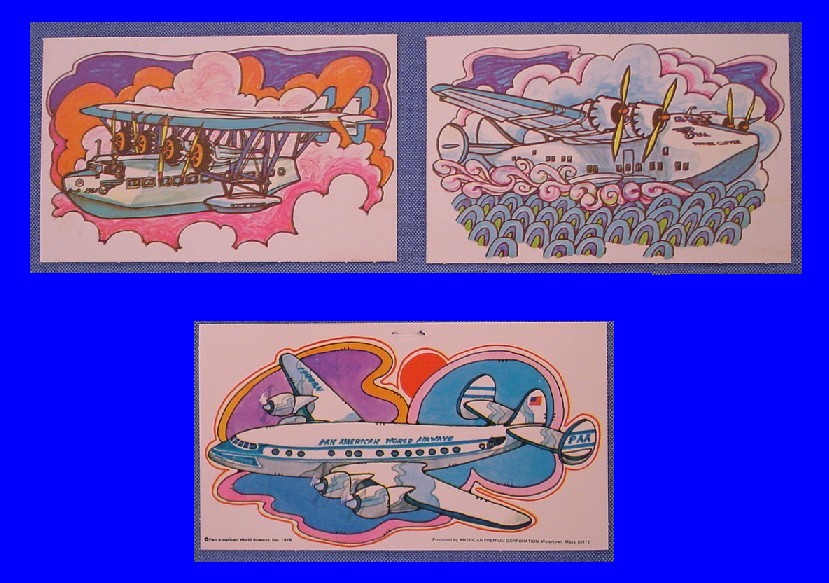
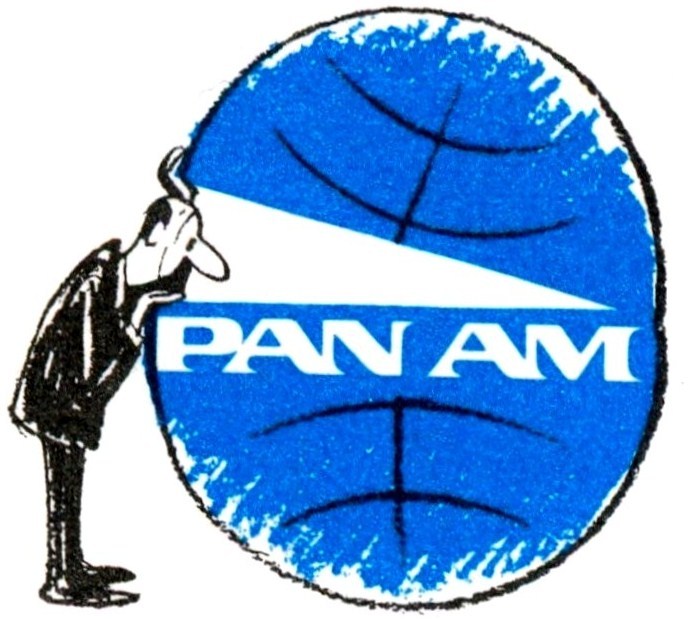
everythingPanAm.com
The Virtual Pan Am Museum
